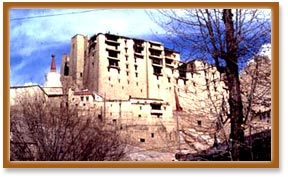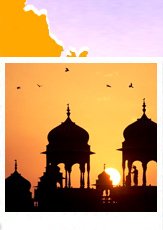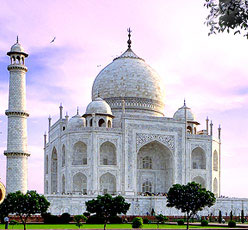 Leh Palace is one of the most captivating architectural ruins that attract the attention of the tourists almost immediately with its majestic setting at the edge of the Namgyal hill and overlooking the town. Built in the 17th century, it was built as the residential palace for the King Singge Namgyal. Much smaller but resembling the Potala in Lhasa, Leh Palace is now in ruins. It has nine storeys and has been deserted since the royal family shifted to the Stok Palace in 1830s. nine storeys, but it is now dilapidated and deserted. It was the home of the royal family until they were exiled to Stok in the 1830s. The Victory Tower set above the palace was built to commemorate the victory of brave Ladakhi soldiers over the invading armies of Balti Kashmiris in the early 16th century. Today, Leh Palace serves as an office for the Indian Government's archaeological conservation organization
Leh Palace is one of the most captivating architectural ruins that attract the attention of the tourists almost immediately with its majestic setting at the edge of the Namgyal hill and overlooking the town. Built in the 17th century, it was built as the residential palace for the King Singge Namgyal. Much smaller but resembling the Potala in Lhasa, Leh Palace is now in ruins. It has nine storeys and has been deserted since the royal family shifted to the Stok Palace in 1830s. nine storeys, but it is now dilapidated and deserted. It was the home of the royal family until they were exiled to Stok in the 1830s. The Victory Tower set above the palace was built to commemorate the victory of brave Ladakhi soldiers over the invading armies of Balti Kashmiris in the early 16th century. Today, Leh Palace serves as an office for the Indian Government's archaeological conservation organizationLeh Palace is an excellent example of the medieval Tibetan architecture. It features colossal inclined buttressed walls and protruding wooden balconies. It has suffered massive destruction being at the receiving end of the Kashmiri cannons and one has to be careful while walking through the ruins, watching out for the gaping holes in the floors and dark staircases. The highlights of the place are flaking murals trying to let the visitors glimpse the erstwhile glory and splendor of the ruined royal apartments and its roof terrace offers picturesque views of the town and the snow-capped Stok Kangri Mountains. Also worth of note is the gloomy Dukhar temple housed on the fourth storey with a thousand armed image of its deity, Goddess Tara, along with some wonderful and peculiar masks, musical instruments and weapons used once as props, to accompany the occasional recitals and religious ceremonies held in the courtyard of the palace outside.









